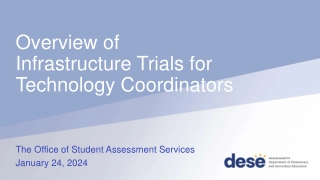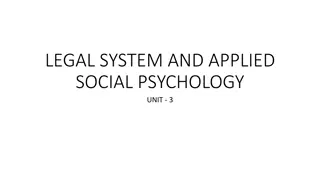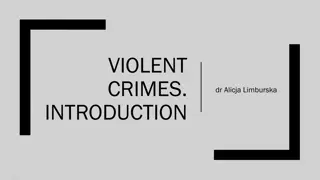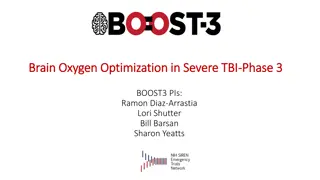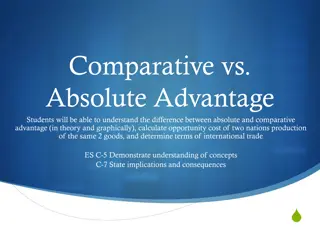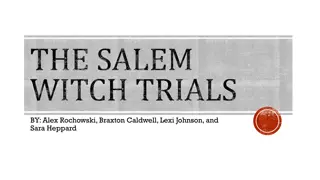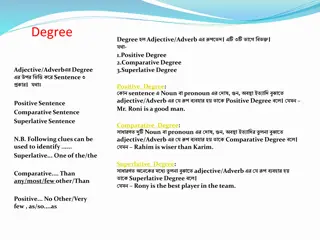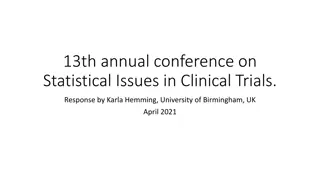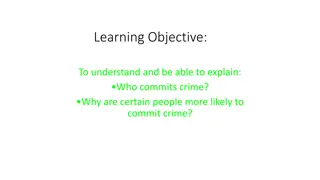Understanding Criminal Trials: A Comparative Look
Explore the stages and participants in criminal proceedings, delve into the nuances of jury trials in the USA, comprehend the burden of proof, and grasp the steps involved in a trial with a focus on evidence presentation and guilt assessment.
Download Presentation

Please find below an Image/Link to download the presentation.
The content on the website is provided AS IS for your information and personal use only. It may not be sold, licensed, or shared on other websites without obtaining consent from the author. Download presentation by click this link. If you encounter any issues during the download, it is possible that the publisher has removed the file from their server.
E N D
Presentation Transcript
Trial - a comparative perspective Dorota Czerwi ska
Criminal proceedings (simplified scheme) FORMAL ACCUSATION Filing appeal Investigation Trial Trial on Appeals COURT OF APPEALS JUDGMENT JUDGMENT verification of information on commitment of a crime identification of a suspect Author: Artur Kowalczyk
Trial THE STAGE DEDICATED TO THE PRESENTATION OF EVIDENCE AND THE ASSESSMENT OF GUILT BY THE COURT AND/OR THE JURY VANISHING IN MODERN CRIMINAL PROCEDURE STILL THE CULMINATIVE STAGE OF PROCEEDINGS
Participants in criminal proceedings (simplified scheme) INVESTIGATION TRIAL PROSECUTION COURT (jury) DECISION MAKERS: POLICE PARTIES: PROSECUTOR SUSPECT VICTIM DEFENDANT Author: Artur Kowalczyk
USA jury trial 6th Amendment to American Constitution constitutionally protected right to a jury trial Case law: It does not extend to petty offences (= no more than 6 months imprisonment imposed Baldwin v. New York 1970) It does not extend to juvenile proceedings Duncan v. Luisiana 1968 right to a jury trial is also incorporated in the due proces clause of 14th Amendment states also have to guarantee that right State juries do not have to consist of 12 jurors, but a minimum of 6 is required Federal juries have to be unanimous State may admit verdicts that were not unanimous unless the jury was composed of 6 members
USA jury selection Three stages: Master jury list Drawing of the venire (jury pool) Voir dire: Excusing jurors for cause Excusing jurors without good cause (peremptory challenges)
USA bench trial It takes place if there is no jury trial or the defendant waives the right to jury trial (variations as to admissibility) One judge
Burden of proof Starting presumptions: Presumption of sanity Presumption of innocence Burden of proof: Burden of production Burden of persuasion standard: beyond a reasonable doubt
Steps in the Trial Renewed motion for a judgment of acquittal Motion for judgment of acquittal The Verdict Closing arguments Opening statements Jury Prosecutor s case-in- chief The Rebuttal instructions and deliberations defence s case-in- chief
Sentencing A separate phase in adversarial procedure Belongs to the judge Other participants: Probation officer Prosecutor Defence attorney
Continental trial 1) Usually no jury (sometimes lay judges involved) 2) Usually no separate sentencing phase 3) Active judge, more passive parties
Trial in Poland Most cases heard by a single professional judge; in felony cases lay judges included; they always outnumber professional judges Burden of proof: On the prosecutor On the court duty to seek the truth No cross-examination
Trial in Poland Summary of charges by the proscutor Presentation of further evidence The court s deliberation Interrogation of the accused Closing statements of the parties The judgment
Results of investigation In adversarial procedur they do not constitute evidence; only what is presented in court is evidence In inquisitorial procedure, all the participants (including the judge) have the access to the dossier (= all the documents from the investigation) and the dossier contains the evidence this changes everything
Summary The trial portrays all the differences between adversarial inquisitorial criminal procedure: and ADVERSARIAL INQUISITORIAL Passive judge Active judge Active parties Passive parties Rules of evidence Less strict rules of evidence Separate sentencing Guilt and sentencing determined in one judgment
Thank you! dorota.czerwinska@uwr.edu.pl



